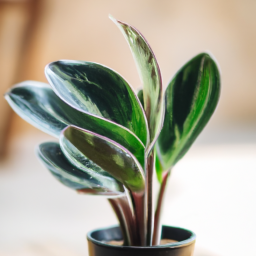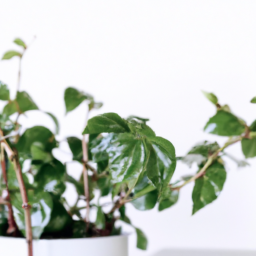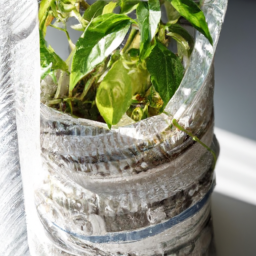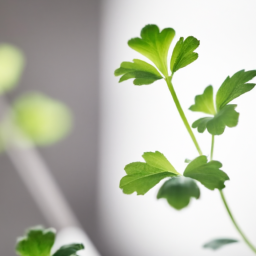
Are you looking to bring some greenery into your home but don’t have access to natural sunlight? Fear not, because indoor light for plants is here to save the day! Many plant enthusiasts struggle with finding the right balance of light for their indoor plants, but with the right knowledge and tools, you can create a thriving indoor garden that will brighten up any space. In this blog post, we will explore the different types of indoor lighting options available for plants, as well as tips and tricks for ensuring your green friends get the light they need to flourish. So sit back, relax, and let’s shed some light on the topic of indoor light for plants.
Benefits of Using Indoor Light for Plants
Introduction
When it comes to growing plants indoors, providing adequate lighting is crucial for their health and growth. While natural sunlight is the best source of light for plants, it may not always be available, especially in areas with limited sunlight or during the winter months. This is where indoor lighting comes in handy, providing plants with the light they need to thrive. In this article, we will explore the benefits of using indoor light for plants and provide you with a step-by-step guide on how to choose the right lighting for your indoor garden.
Improved Plant Growth
One of the main benefits of using indoor light for plants is that it can significantly improve their growth. Plants need light to photosynthesize and produce energy for growth. Without adequate light, plants may become leggy, stunted, or fail to flower or fruit. By providing plants with the right amount and quality of light, you can promote healthy growth and ensure that your plants reach their full potential.
In addition to promoting overall growth, indoor lighting can also help plants develop stronger stems and leaves. Plants that receive insufficient light may become weak and prone to diseases and pests. By providing plants with the right amount of light, you can help them build a strong structure that can support their growth and development.
Another benefit of using indoor light for plants is that it can help regulate their growth cycles. Many plants require a certain amount of light each day to trigger flowering or fruiting. By providing plants with consistent light, you can help them maintain their growth cycles and ensure that they produce flowers or fruits at the right time.
Extended Growing Season
Indoor lighting can also help extend the growing season for plants, allowing you to grow a wider variety of plants throughout the year. In areas with short growing seasons or harsh weather conditions, indoor lighting can provide plants with the light they need to continue growing and producing even when outdoor conditions are not ideal.
By using indoor lighting, you can create a controlled environment for your plants, ensuring that they receive the right amount of light, temperature, and humidity to thrive. This can be especially beneficial for growing plants that are not native to your region or that require specific growing conditions. With indoor lighting, you can create a microclimate that mimics the plants’ natural habitat, allowing them to grow and thrive year-round.
In addition to extending the growing season, indoor lighting can also help you start plants earlier in the spring or grow plants later into the fall. By providing plants with the right amount of light, you can encourage faster growth and ensure that your plants are ready to be transplanted outdoors when the weather warms up.
Overall, using indoor light for plants can provide a wide range of benefits, from promoting healthy growth to extending the growing season. By choosing the right lighting and providing plants with the light they need, you can create a thriving indoor garden that will bring you joy and satisfaction year-round.

Types of Indoor Lights for Plant Growth
Fluorescent Lights
Fluorescent lights are a popular choice for indoor plant growth due to their affordability and efficiency. These lights come in two main types: T5 and T8. T5 bulbs are more energy-efficient and produce more light than T8 bulbs, making them a better choice for plants that require high levels of light. T8 bulbs, on the other hand, are more cost-effective and are suitable for plants that do not need as much light.
When using fluorescent lights for indoor plants, it is important to position the lights close to the plants, as these lights do not have a high intensity. This will ensure that the plants receive an adequate amount of light for photosynthesis. Additionally, fluorescent lights should be kept on for 12-16 hours a day to mimic natural daylight.
One drawback of fluorescent lights is that they do not emit as much red and blue light, which are essential for plant growth. To compensate for this, you can supplement fluorescent lights with LED grow lights that provide the necessary spectrum of light for optimal plant growth.
In conclusion, fluorescent lights are a cost-effective option for indoor plant growth, but may require supplementation with other types of lights to ensure that plants receive the full spectrum of light they need.
LED Grow Lights
LED grow lights have become increasingly popular for indoor plant growth due to their energy efficiency and ability to provide plants with the specific spectrum of light they need for optimal growth. These lights come in a variety of colors, including red and blue, which are essential for photosynthesis.
One of the main advantages of LED grow lights is their longevity. These lights can last up to 50,000 hours, making them a cost-effective option in the long run. Additionally, LED grow lights produce less heat than other types of lights, reducing the risk of burning the plants.
When using LED grow lights for indoor plants, it is important to choose the right color spectrum for the specific needs of your plants. For example, plants that are in the vegetative stage require more blue light, while plants in the flowering stage require more red light. You can also adjust the intensity of the lights to meet the needs of your plants.
In conclusion, LED grow lights are a versatile and energy-efficient option for indoor plant growth, providing plants with the specific spectrum of light they need for optimal growth.
High-Intensity Discharge (HID) Lights
High-Intensity Discharge (HID) lights are another popular choice for indoor plant growth, particularly for plants that require high levels of light. There are two main types of HID lights: Metal Halide (MH) and High-Pressure Sodium (HPS). MH lights emit a blue spectrum of light, which is ideal for plants in the vegetative stage, while HPS lights emit a red spectrum of light, which is ideal for plants in the flowering stage.
One of the main advantages of HID lights is their high intensity, which makes them suitable for plants that require high levels of light for optimal growth. However, these lights also produce a significant amount of heat, so it is important to monitor the temperature in the growing area to prevent the plants from burning.
When using HID lights for indoor plants, it is important to position the lights at the correct distance from the plants to ensure that they receive an adequate amount of light. Additionally, HID lights should be kept on for 12-18 hours a day, depending on the specific needs of the plants.
In conclusion, HID lights are a powerful option for indoor plant growth, providing plants with the high levels of light they need for optimal growth. However, it is important to monitor the temperature in the growing area to prevent the plants from burning.

Tips for Choosing the Right Indoor Light for Your Plants
As an expert in indoor light for plants, I understand the importance of providing your plants with the right amount and type of light to thrive indoors. With so many options available on the market, it can be overwhelming to choose the best indoor light for your plants. In this guide, I will provide you with valuable tips to help you make an informed decision when selecting indoor light for your plants.
Understanding the Different Types of Indoor Light
When it comes to choosing the right indoor light for your plants, it is essential to understand the different types of light available. The three main types of indoor light are:
1. Natural Light: Natural light is the best source of light for plants as it provides a full spectrum of light that plants need to grow and thrive. However, not all indoor spaces receive adequate natural light, especially during the winter months.
2. Fluorescent Light: Fluorescent lights are a popular choice for indoor plants as they are energy-efficient and provide a good amount of light for plant growth. They are available in different spectrums, including cool white, warm white, and full spectrum.
3. LED Light: LED lights have become increasingly popular for indoor plant growth due to their energy efficiency and ability to provide specific light spectrums that plants need for photosynthesis. They are available in various colors, including red, blue, and white.
Factors to Consider When Choosing Indoor Light
When selecting indoor light for your plants, there are several factors to consider to ensure that your plants receive the right amount and type of light for optimal growth:
1. Light Intensity: Different plants have varying light intensity requirements. Some plants require high light intensity, while others thrive in low light conditions. Consider the light requirements of your plants when choosing indoor light.
2. Light Duration: The duration of light exposure is crucial for plant growth. Most plants require 12-16 hours of light per day for healthy growth. Consider using a timer to ensure consistent light exposure for your plants.
3. Light Spectrum: Different plants require specific light spectrums for photosynthesis. Choose indoor light that provides the right spectrum of light for your plants’ growth stage, such as blue light for vegetative growth and red light for flowering.
Tips for Choosing the Right Indoor Light
Here are some additional tips to help you choose the right indoor light for your plants:
1. Consider the size of your indoor space and the number of plants you have when selecting the right light fixture.
2. Invest in a light meter to measure the intensity of light in your indoor space and adjust the light levels accordingly.
3. Rotate your plants regularly to ensure even light distribution and promote balanced growth.
By following these tips and considerations, you can choose the right indoor light for your plants and create an optimal growing environment for healthy plant growth.
Here’s what we learned
Have you ever wondered why your indoor plants aren’t thriving as well as they could be? It might be because they’re not getting enough light. Just like humans, plants need light to grow and thrive. But sometimes, natural light just isn’t enough, especially if you live in a place with long winters or limited sunlight. That’s where indoor lighting comes in.
Indoor lighting for plants can help supplement natural light and ensure that your plants are getting the right amount of light they need to grow healthy and strong. From fluorescent to LED lights, there are a variety of options to choose from based on your plant’s specific needs. By understanding the importance of indoor lighting for plants and choosing the right type of light for your space, you can help your plants flourish and brighten up your home all year round.
Frequently Asked Questions (FAQ):
Q1: What type of indoor light is best for plants?
A1: The best type of indoor light for plants is a full spectrum LED grow light. This type of light provides the necessary wavelengths of light that plants need for photosynthesis.
Q2: How far should indoor lights be from plants?
A2: Indoor lights should be placed about 12-18 inches away from plants to ensure they are receiving enough light without burning the leaves.
Q3: How long should indoor lights be left on for plants?
A3: Indoor lights should be left on for about 12-16 hours a day to mimic the natural daylight cycle that plants need for healthy growth.
Q4: Can any indoor light be used for plants?
A4: Not all indoor lights are suitable for plants. It is best to use full spectrum LED grow lights specifically designed for plant growth to ensure they are getting the right wavelengths of light.
Q5: Do plants need darkness at night?
A5: Yes, plants need a period of darkness at night to rest and undergo important processes like respiration. It is important to give plants a break from light to maintain their natural cycle.
Dr. Olivia Green is a botanist with over two decades of experience in indoor plant cultivation. She holds a Ph.D. in Plant Biology and has dedicated her career to researching plant behavior in controlled environments. Dr. Green is passionate about helping plant enthusiasts master the art of indoor gardening through her extensive knowledge and practical insights.


